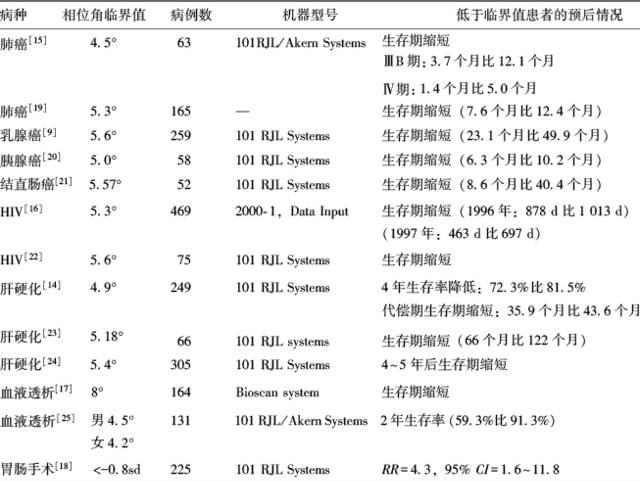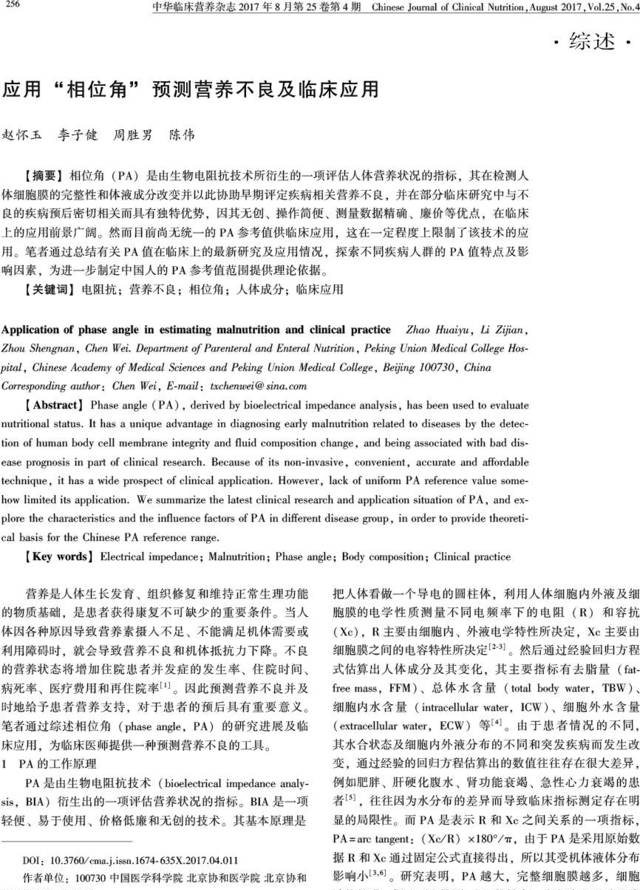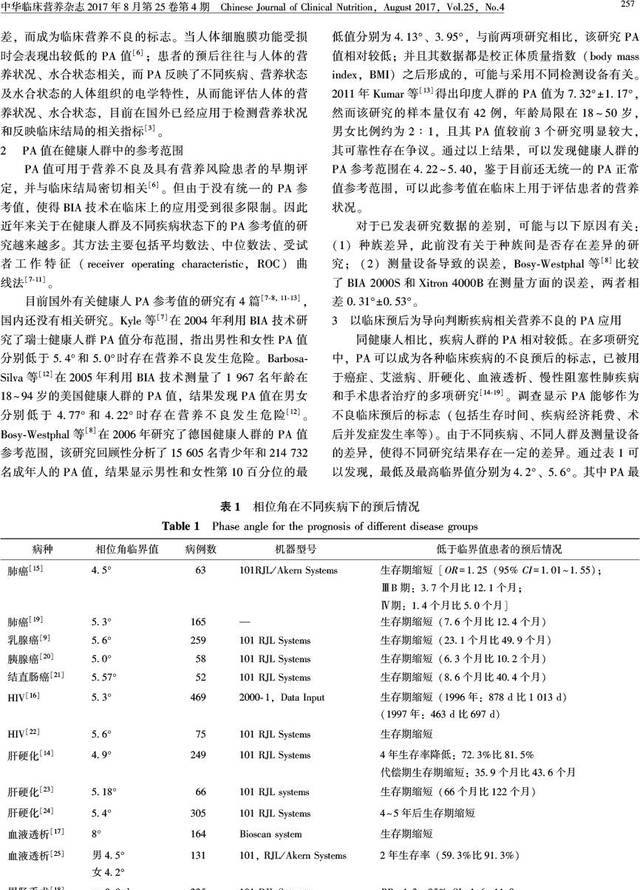赵怀玉,李子健,周胜男,陈伟
中国医学科学院
北京协和医学院
北京协和医院
肠外肠内营养科
相位角是由生物电阻抗技术所衍生的一项评估人体营养状况的指标,其在检测人体细胞膜的完整性和体液成分改变并以此协助早期评定疾病相关营养不良,并在部分临床研究中与不良的疾病结局密切相关而具有独特优势,因其无创、操作简便、测量数据精确、廉价等优点,在临床上的应用前景广阔。然而目前尚无统一的相位角参考值供临床应用,这在一定程度上限制了该技术的应用。笔者通过总结有关相位角值在临床上的最新研究及应用情况,探索不同疾患者群的相位角值特点及影响因素,为进一步制定中国人的相位角参考值范围提供理论依据。
通信作者:陈伟(txchenwei@sina.com)
原文参见:中华临床营养杂志. 2017;25(4):256-260.
营养是人体生长发育、组织修复和维持正常生理功能的物质基础,是患者获得康复不可缺少的重要条件。当人体因各种原因导致营养素摄入不足、不能满足机体需要或利用障碍时,就会导致营养不良和机体抵抗力下降。不良的营养状态将增加住院患者并发症的发生率、住院时间、病死率、医疗费用和再住院率【1】。因此预测营养不良并及时地给予患者营养支持,对于患者的结局具有重要意义。笔者通过综述相位角的研究进展及临床应用,为临床医师提供一种预测营养不良的工具。
1 相位角的工作原理
相位角是由生物电阻抗技术(BIA)衍生出的一项评估营养状况的指标。BIA是一项轻便、易于使用、价格低廉和无创的技术。其基本原理是把人体看做一个导电的圆柱体,利用人体细胞内外液及细胞膜的电学性质测量不同电频率下的电阻和容抗,电阻主要由细胞内、外液电学特性所决定,容抗主要由细胞膜之间的电容特性所决定【2,3】。然后通过经验回归方程式估算出人体成分及其变化,其主要指标有去脂量、全身水含量、细胞内水含量、细胞外水含量等【4】。由于患者情况的不同,其水合状态及细胞内外液分布的不同和突发疾病而发生改变,通过经验的回归方程估算出的数值往往存在很大差异,例如肥胖、肝硬化腹水、肾功能衰竭、急性心力衰竭的患者【5】,往往因为水分布的差异而导致临床指标测定存在明显的局限性。而相位角是表示电阻和容抗之间关系的一项指标,相位角=反正切(容抗÷电阻)×180°÷π,由于相位角是采用原始数据电阻和容抗通过固定公式直接得出,所以其受机体液体分布影响小【3,6】。研究表明,相位角越大,完整细胞膜越多,细胞功能越强。据此可以推测,相位角能够在一定程度上反映细胞的健康和营养状态。较小的相位角可以解释为体细胞健康状况差,而成为临床营养不良的标志。当人体细胞膜功能受损时会表现出较低的相位角值【6】;患者的结局往往与人体的营养状况、水合状态相关,而相位角反映了不同疾病、营养状态及水合状态的人体组织的电学特性,从而能评估人体的营养状况、水合状态,目前在国外已经应用于检测营养状况和反映临床结局的相关指标【3】。
2 相位角值在健康人群中的参考范围
相位角值可用于营养不良及具有营养风险患者的早期评定,并与临床结局密切相关【6】。但由于没有统一的相位角参考值,使得BIA技术在临床上的应用受到很多限制。因此近年来关于在健康人群及不同疾病状态下的相位角参考值的研究越来越多。其方法主要包括平均数法、中位数法、受试者工作特征曲线法【7-11】。
目前国外有关健康人相位角参考值的研究有4篇【7,8,11-13】,国内还没有相关研究。Kyle等【7】在2004年利用BIA技术研究了瑞士健康人群相位角值分布范围,指出男性和女性相位角值分别低于5.4°和5.0°时存在营养不良发生危险。Barbosa-Silva等【12】在2005年利用BIA技术测量了1967名年龄在18~94岁的美国健康人群的相位角值,结果发现相位角值在男女分别低于4.77°和4.22°时存在营养不良发生危险【12】。Bosy-Westphal等【8】在2006年研究了德国健康人群的相位角值参考范围,该研究回顾性分析了15605名青少年和214732名成年人的相位角值,结果显示男性和女性第10百分位的最低值分别为4.13°、3.95°,与前两项研究相比,该研究相位角值相对较低;并且其数据都是校正体重指数之后形成的,可能与采用不同检测设备有关。2011年Kumar等【13】得出印度人群的相位角值为7.32°±1.17°,然而该研究的样本量仅有42例,年龄局限在18~50岁,男女比例约为2∶1,且其相位角值较前3个研究明显较大,其可靠性存在争议。通过以上结果,可以发现健康人群的相位角参考范围在4.22~5.40,鉴于目前还无统一的相位角正常值参考范围,可以此参考值在临床上用于评估患者的营养状况。
对于已发表研究数据的差别,可能与以下原因有关:①种族差异,此前没有关于种族间是否存在差异的研究;②测量设备导致的误差,Bosy-Westphal等【8】比较了BIA 2000S和Xitron 4000B在测量方面的误差,两者相差0.31°±0.53°。
3 以临床结局为导向判断疾病相关营养不良的相位角应用
同健康人相比,疾患者群的相位角相对较低。在多项研究中,相位角可以成为各种临床疾病的不良结局的标志,已被用于癌症、艾滋病、肝硬化、血液透析、慢性阻塞性肺疾病和手术患者治疗的多项研究【14-19】。调查显示相位角能够作为不良临床结局的标志(包括生存时间、疾病经济耗费、术后并发症发生率等)。由于不同疾病、不同人群及测量设备的差异,使得不同研究结果存在一定的差异。通过表1可以发现,最低及最高临界值分别为4.2°、5.6°。其中相位角最高临界值为8°的研究,其测试设备与其他研究的设备不同,数值差距较大,因此未予采用【17】。这些研究结果显示,在癌症、肝硬化、人类免疫缺陷病毒(HIV)感染、血液透析及胃肠手术的患者中,处于相位角值低限的患者,其生存期会显著缩短、死亡率显著增加、术后并发症的发生率显著增加。因此在临床上,这些临界值有助于临床医师判断患者的结局情况,并可通过营养干预措施提高患者的相位角值,进而改善患者的结局。然而目前还没有相关的前瞻性研究来说明怎样的干预措施可以提高相位角值以及提高相位角值后是否可以改善预后。这也是未来相位角研究的方向。
表1、相位角在不同疾病下的预后情况

4 相位角值的影响因素
在健康成人中,年龄、性别和体重指数是相位角值的决定因素【8,12,26-27】,其他可能的影响因素包括:体重指数【12,26】、主观全面评价法【8】、C反应蛋白【28】、白细胞介素6【29】等。根据文献报道,男性人群较女性人群有更高的相位角值,这可能是由于男性拥有较多的肌肉量。在30~40岁之前,随着年龄的增长,相位角值逐渐增加,在40岁以后,随着年龄的增加,相位角值逐渐降低,这可能是由于在30岁之前,随着年龄的增加,肌肉量也在不断增加,在30~40岁人体肌肉量达到最高值,此后随着年龄的增长,肌肉开始萎缩【8,12】。而且,相位角值也会随着体重指数的增加而增加,这可能是由于细胞量的增加,然而这种关系仅仅在体重指数<30kg/m²时能被观察到,当体重指数>40kg/m²时,其关系却相反,这主要是由于水分过载导致更高的组织水合作用的结果或者由于脂肪组织中细胞外液与细胞内液水分比值的增加所导致。此外增加体育锻炼也扮演着重要角色,其可能主要是由于体育锻炼使得人体肌肉量增加,进而影响相位角值【8,27-30】。
在疾病状态下,由于感染、炎症或者特定疾病能减低体细胞值,使其相位角值往往低于健康人。例如结核病合并HIV感染患者的相位角值要比单独的HIV感染患者明显降低【31】;然而恶性肿瘤并不是决定相位角值的唯一因素【28】。这些影响因素均是通过横断面研究得出的结论,目前还没有相关的前瞻性研究来证实其影响效应,也没有相关研究提示改变某种影响因素是否能提高或降低患者的相位角值。由于相位角值的大小与营养不良、病程进展、疾病结局等密切相关,因此对于相位角值影响的因素仍值得进一步研究,以便通过干预手段提高患者的相位角值。
5 相位角在中国的应用情况及发展前景
通过在万方数据库和中国知网数据库搜索关键词:BIA、生物电阻抗、相位角、phase angle等,结果发现目前国内关于BIA技术的应用情况主要包括以下几方面:①测量人体成分:如通过比较士兵和学生之间的人体成分,得出运动对人体成分组成有很大的影响,体育锻炼对健康有十分重要的作用。同时还可用于测量儿童的体成分,从而有助于临床医师对于儿童营养方面的指导【32,33】。②检测疾病进展的情况,如长期腹膜透析患者的脂肪量会增加,可准确评估血液透析患者残余肾功能、用于对肝功能的分级【35-37】。③用BIA长期检测透析的营养不良患者的人体成分是必要的,可更早发现维持性血液透析患者的营养不良【35,36】。此外,BIA用于评估严重烧伤患者的营养代谢【39】,用于检测胃肠道肿瘤患者术前及放疗时的营养状况,从而可及时给予营养支持【40,41】。然而目前关于相位角的相关研究及临床应用,国内还没有相关文献报道。同时建立健康人群相位角值参考范围对于营养不良的评定、疾病进程的检测及疾病结局的预测会有很大帮助,并有助于对营养不良进行临床分级。
综上,相较常规BIA检测体成分,相位角能够用于评价人体营养状况及预测疾病的结局。通过对患者的相位角值分析,临床医师可知道哪些患者具有不良临床结局的高风险,从而加强这些患者的营养。相位角的检测仪器越趋小型化,检测十分方便快捷。目前的研究大多都是关于相位角评价人体营养状况及疾病结局的,如何提高相位角值、提高相位角值能否改善患者临床结局以及通过相位角值进行营养分级等,还值得进一步研究。并且目前的研究大多数都是国外的,亟待建立我国人群的数据模型。
参考文献
Arnaud-Battandier F, Malvy D, Jeandel C, et al. Use of oral supplements in malnourished elderly patients living in the community: a pharmaco-economic study. Clin Nutr. 2004;23(5):1096-1103. DOI: 10.1016/j.clnu.2004.02.007
Kyle UG, Bosaeus I, De Lorenzo AD, et al. Bioelectrical impedance analysis part I: review of principles and methods. Clin Nutr. 2004;23(5):1226-1243. DOI: 10.1016/j.clnu.2004.06.004
Dey DK, Bosaeus I. Comparison of bioelectrical impedance prediction equations for fat-free mass in a population-based sample of 75 y olds: the NORA study. Nutrition. 2003;19(10):858-864. DOI: 10.1016/S0899-9007(03)00172-2
Kyle UG, Piccoli A, Pichard C. Body composition measurements: interpretation finally made easy for clinical use. Curr Opin Clin Nutr Metab Care. 2003;6(4):387-393. DOI: 10.1097/01.mco.0000078988.18774.3d
Norman K, Stobäus N, Pirlich M, et al. Bioelectrical phase angle and impedance vector analysis-clinical relevance and applicability of impedance parameters. Clin Nutr. 2012;31(6):854-861. DOI: 10.1016/j.clnu.2012.05.008
Stegel P, Kozjek NR, Brumen BA, et al. Bioelectrical impedance phase angle as indicator and predictor of cachexia in head and neck cancer patients treated with (chemo)radiotherapy. Eur J Clin Nutr. 2016;70(5):602-626. DOI: 10.1038/ejcn.2016.13
Kyle UG, Genon L, Karsegard VL, et al. Percentiles (10,25,75 and 90th) for phase angle (Pha), determined by bioelectrical impedance analysis (BIA) in 2740 healthy aduts aged 20-75 yr. Clin Nutr. 2004;23:758.
Bosy-Westphal A, Danielzik S, Dörhöfer RP, et al. Phase angle from bioelectrical impedance analysis: population reference values by age, sex, and body mass index. JPEN J Parenter Enteral Nutr. 2006;30(4):309-316. DOI: 10.1177/0148607106030004309
Gupta D, Lammersfeld CA, Vashi PG, et al. Bioelectrical impedance phase angle as a prognostic indicator in breast cancer. BMC Cancer. 2008;8:249. DOI: 10.1186/1471-2407-8-249
Souza Thompson Motta R, Alves Castanho I, Guillermo Coca Velarde L. Cutoff point of the phase angle in pre-radiotherapy cancer patients. Nutr Hosp. 2015;32(5):2253-2260. DOI: 10.3305/nh.2015.32.5.9626
Varan HD, Bolayir B, Kara O, et al. Phase angle assessment by bioelectrical impedance analysis and its predictive value for malnutrition risk in hospitalized geriatric patients. Aging Clin Exp Res. 2016;28(6):1121-1126. DOI: 10.1007/s40520-015-0528-8
Barbosa-Silva MC, Barros AJ, Wang J, et al. Bioelectrical impedance analysis: population reference values for phase angle by age and sex. Am J Clin Nutr. 2005;82(1):49-52.
Kumar S, Dutt A, Hemraj S, et al. Phase angle measurement in healthy human subjects through bio-impedance analysis. Iran J Basic Med Sci. 2012;15(6):1180-1184.
Ruiz-Margáin A, Macías-Rodríguez RU, Duarte-Rojo A, et al. Malnutrition assessed through phase angle and its relation to prognosis in patients with compensated liver cirrhosis: a prospective cohort study. Dig Liver Dis. 2015;47(4):309-314. DOI: 10.1016/j.dld.2014.12.015
Toso S, Piccoli A, Gusella M, et al. Altered tissue electric properties in lung cancer patients as detected by bioelectric impedance vector analysis. Nutrition. 2000;16(2):120-124. DOI: 10.1016/S0899-9007(99)00230-0
Schwenk A, Beisenherz A, Römer K, et al. Phase angle from bioelectrical impedance analysis remains an independent predictive marker in HIV-infected patients in the era of highly active antiretroviral treatment. Am J Clin Nutr. 2000;72(2):496-501.
Abad S, Sotomayor G, Vega A, et al. The phase angle of electrical impedance is a predictor of long-term survival in dialysis patients. Nefrologia. 2011;31(6):670-676. DOI: 10.3265/Nefrologia
Barbosa-Silva MC, Barros AJ. Bioelectric impedance and individual characteristics as prognostic factors for post-operative complications. Clin Nutr. 2005;24(5):830-838. DOI: 10.1016/j.clnu.2005.05.005
Gupta D, Lammersfeld CA, Vashi PG, et al. Bioelectrical impedance phase angle in clinical practice: implications for prognosis in stage IIIB and IV non-small cell lung cancer. BMC Cancer. 2009;9:37. DOI: 10.1186/1471-2407-9-37
Gupta D, Lis CG, Dahlk SL, et al. Bioelectrical impedance phase angle as a prognostic indicator in advanced pancreatic cancer. Br J Nutr. 2004;92(6):957. DOI: 10.1079/BJN20041292
Gupta D, Lammersfeld CA, Burrows JL, et al. Bioelectrical impedance phase angle in clinical practice: implications for prognosis in advanced colorectal cancer. Am J Clin Nutr. 2004;80(6):1634-1638.
Ott M, Fischer H, Polat H, et al. Bioelectrical impedance analysis as a predictor of survival in patients with human immunodeficiency virus infection. J Acquir Immune Defic Syndr Hum Retrovirol. 1995;9(1):20-25.
Peres WA, Lento DF, Baluz K, et al. Phase angle as a nutritional evaluation tool in all stages of chronic liver disease. Nutr Hosp. 2012;27(6):2072-2078. DOI: 10.3305/nh.2012.27.6.6015
Selberg O, Selberg D. Norms and correlates of bioimpedance phase angle in healthy human subjects, hospitalized patients, and patients with liver cirrhosis. Eur J Appl Physiol. 2002;86(6):509-516. DOI: 10.1007/s00421-001-0570-4
Maggiore Q, Nigrelli S, Ciccarelli C, et al. Nutritional and prognostic correlates of bioimpedance indexes in hemodialysis patients. Kidney Int. 1996;50(6):2103-2108. DOI: 10.1038/ki.1996.535
Dittmar M. Reliability and variability of bioimpedance measures in normal adults: effects of age, gender, and body mass. Am Phys Anthropol. 2003;122(4):361-370. DOI: 10.1002/ajpa.10301
Torres AG, Oliveira KJ, Oliveirajunior AV, et al. Biological determinants of phase angle among Brazilian elite athletes. Pro Nutr Soc. 2008;67(OCE8):E332. DOI: 10.1017/S0029665108000062
Stobäus N, Pirlich M, Valentini L, et al. Determinants of bioelectrical phase angle in disease. Br J Nutr. 2012;107(8):1217-1220. DOI: 10.1017/S0007114511004028
Maggiore Q, Nigrelli S, Ciccarelli C, et al. Nutritional and prognostic correlates of bioimpedance indexes in hemodialysis patients. Kidney Int. 1996;50(6):2103-2108. DOI: 10.1038/ki.1996.535
Demirci MS, Demirci C, Ozdogan O, et al. Relations between malnutrition-inflammation-atherosclerosis and volume status. The usefulness of bioimpedance analysis in peritoneal dialysis patients. Nephrol Dial Transplant. 2011;26(5):1708-1716. DOI: 10.1093/ndt/gfq588
赵长海, 孙丽娟, 薛婧. 生物电阻抗法在战士体成分调查及分析中的应用. 陕西医学杂志. 2009;38(2):229-231. DOI: 10.3969/j.issn.1000-7377.2009.02.043
孙文杰, 王京钟. 生物电阻抗法在儿童青少年体成分研究中的应用. 国外医学(卫生学分册). 2006;33(3):175-178.
梁勇, 黄恒洁, 何国容, 等. 腹膜透析病人体内的脂肪分布. 广东医学. 2015;36(6):868-869.
黎晓磊. 应用生物电阻抗法评估血液透析病人残余肾功能. 实用医学杂志. 2015;31(5):770-774. DOI: 10.3969/j.issn.1006-5725.2015.05.025
张运芝. 肝硬化病人营养不良评估的新进展. 世界华人消化杂志. 2015(15):2404-2409.
王志远, 王富生. 生物电阻抗法评估严重烧伤后营养代谢. 南方医科大学学报. 2008;28(12):2247-2249. DOI: 10.3321/j.issn.1673-4254.2008.12.048
佴永军, 江志伟, 汪志明, 等. 胃肠道肿瘤病人术前人体组成分析的研究. 肠外与肠内营养. 2005;12(6):349-351. DOI: 10.3969/j.issn.1007-810X.2005.06.009
丁慧萍. 生物电阻抗分析在胃癌病人放疗期间营养评估中的应用. 世界华人消化杂志. 2015(22):3597-3603.
Arnaud-Battandier F, Malvy D, Jeandel C, et al. Use of oral supplements in malnourished elderly patients living in the community: a pharmaco-economic study. Clin Nutr. 2004;23(5):1096-1103. DOI: 10.1016/j.clnu.2004.02.007
Kyle UG, Bosaeus I, De Lorenzo AD, et al. Bioelectrical impedance analysis part I: review of principles and methods. Clin Nutr. 2004;23(5):1226-1243. DOI: 10.1016/j.clnu.2004.06.004
Dey DK, Bosaeus I. Comparison of bioelectrical impedance prediction equations for fat-free mass in a population-based sample of 75 y olds: the NORA study. Nutrition. 2003;19(10):858-864. DOI: 10.1016/S0899-9007(03)00172-2
Kyle UG, Piccoli A, Pichard C. Body composition measurements: interpretation finally made easy for clinical use. Curr Opin Clin Nutr Metab Care. 2003;6(4):387-393. DOI: 10.1097/01.mco.0000078988.18774.3d
Norman K, Stobäus N, Pirlich M, et al. Bioelectrical phase angle and impedance vector analysis-clinical relevance and applicability of impedance parameters. Clin Nutr. 2012;31(6):854-861. DOI: 10.1016/j.clnu.2012.05.008
Stegel P, Kozjek NR, Brumen BA, et al. Bioelectrical impedance phase angle as indicator and predictor of cachexia in head and neck cancer patients treated with (chemo)radiotherapy. Eur J Clin Nutr. 2016;70(5):602-626. DOI: 10.1038/ejcn.2016.13
Kyle UG, Genon L, Karsegard VL, et al. Percentiles (10,25,75 and 90th) for phase angle (Pha), determined by bioelectrical impedance analysis (BIA) in 2740 healthy aduts aged 20-75 yr. Clin Nutr. 2004;23:758.
Bosy-Westphal A, Danielzik S, Dörhöfer RP, et al. Phase angle from bioelectrical impedance analysis: population reference values by age, sex, and body mass index. JPEN J Parenter Enteral Nutr. 2006;30(4):309-316. DOI: 10.1177/0148607106030004309
Gupta D, Lammersfeld CA, Vashi PG, et al. Bioelectrical impedance phase angle as a prognostic indicator in breast cancer. BMC Cancer. 2008;8:249. DOI: 10.1186/1471-2407-8-249
Souza Thompson Motta R, Alves Castanho I, Guillermo Coca Velarde L. Cutoff point of the phase angle in pre-radiotherapy cancer patients. Nutr Hosp. 2015;32(5):2253-2260. DOI: 10.3305/nh.2015.32.5.9626
Varan HD, Bolayir B, Kara O, et al. Phase angle assessment by bioelectrical impedance analysis and its predictive value for malnutrition risk in hospitalized geriatric patients. Aging Clin Exp Res. 2016;28(6):1121-1126. DOI: 10.1007/s40520-015-0528-8
Barbosa-Silva MC, Barros AJ, Wang J, et al. Bioelectrical impedance analysis: population reference values for phase angle by age and sex. Am J Clin Nutr. 2005;82(1):49-52.
Kumar S, Dutt A, Hemraj S, et al. Phase angle measurement in healthy human subjects through bio-impedance analysis. Iran J Basic Med Sci. 2012;15(6):1180-1184.
Ruiz-Margáin A, Macías-Rodríguez RU, Duarte-Rojo A, et al. Malnutrition assessed through phase angle and its relation to prognosis in patients with compensated liver cirrhosis: a prospective cohort study. Dig Liver Dis. 2015;47(4):309-314. DOI: 10.1016/j.dld.2014.12.015
Toso S, Piccoli A, Gusella M, et al. Altered tissue electric properties in lung cancer patients as detected by bioelectric impedance vector analysis. Nutrition. 2000;16(2):120-124. DOI: 10.1016/S0899-9007(99)00230-0
Schwenk A, Beisenherz A, Römer K, et al. Phase angle from bioelectrical impedance analysis remains an independent predictive marker in HIV-infected patients in the era of highly active antiretroviral treatment. Am J Clin Nutr. 2000;72(2):496-501.
Abad S, Sotomayor G, Vega A, et al. The phase angle of electrical impedance is a predictor of long-term survival in dialysis patients. Nefrologia. 2011;31(6):670-676. DOI: 10.3265/Nefrologia
Barbosa-Silva MC, Barros AJ. Bioelectric impedance and individual characteristics as prognostic factors for post-operative complications. Clin Nutr. 2005;24(5):830-838. DOI: 10.1016/j.clnu.2005.05.005
Gupta D, Lammersfeld CA, Vashi PG, et al. Bioelectrical impedance phase angle in clinical practice: implications for prognosis in stage IIIB and IV non-small cell lung cancer. BMC Cancer. 2009;9:37. DOI: 10.1186/1471-2407-9-37
Gupta D, Lis CG, Dahlk SL, et al. Bioelectrical impedance phase angle as a prognostic indicator in advanced pancreatic cancer. Br J Nutr. 2004;92(6):957. DOI: 10.1079/BJN20041292
Gupta D, Lammersfeld CA, Burrows JL, et al. Bioelectrical impedance phase angle in clinical practice: implications for prognosis in advanced colorectal cancer. Am J Clin Nutr. 2004;80(6):1634-1638.
Ott M, Fischer H, Polat H, et al. Bioelectrical impedance analysis as a predictor of survival in patients with human immunodeficiency virus infection. J Acquir Immune Defic Syndr Hum Retrovirol. 1995;9(1):20-25.
Peres WA, Lento DF, Baluz K, et al. Phase angle as a nutritional evaluation tool in all stages of chronic liver disease. Nutr Hosp. 2012;27(6):2072-2078. DOI: 10.3305/nh.2012.27.6.6015
Selberg O, Selberg D. Norms and correlates of bioimpedance phase angle in healthy human subjects, hospitalized patients, and patients with liver cirrhosis. Eur J Appl Physiol. 2002;86(6):509-516. DOI: 10.1007/s00421-001-0570-4
Maggiore Q, Nigrelli S, Ciccarelli C, et al. Nutritional and prognostic correlates of bioimpedance indexes in hemodialysis patients. Kidney Int. 1996;50(6):2103-2108. DOI: 10.1038/ki.1996.535
Dittmar M. Reliability and variability of bioimpedance measures in normal adults: effects of age, gender, and body mass. Am Phys Anthropol. 2003;122(4):361-370. DOI: 10.1002/ajpa.10301
Torres AG, Oliveira KJ, Oliveirajunior AV, et al. Biological determinants of phase angle among Brazilian elite athletes. Pro Nutr Soc. 2008;67(OCE8):E332. DOI: 10.1017/S0029665108000062
Stobäus N, Pirlich M, Valentini L, et al. Determinants of bioelectrical phase angle in disease. Br J Nutr. 2012;107(8):1217-1220. DOI: 10.1017/S0007114511004028
Maggiore Q, Nigrelli S, Ciccarelli C, et al. Nutritional and prognostic correlates of bioimpedance indexes in hemodialysis patients. Kidney Int. 1996;50(6):2103-2108. DOI: 10.1038/ki.1996.535
Demirci MS, Demirci C, Ozdogan O, et al. Relations between malnutrition-inflammation-atherosclerosis and volume status. The usefulness of bioimpedance analysis in peritoneal dialysis patients. Nephrol Dial Transplant. 2011;26(5):1708-1716. DOI: 10.1093/ndt/gfq588
赵长海, 孙丽娟, 薛婧. 生物电阻抗法在战士体成分调查及分析中的应用. 陕西医学杂志. 2009;38(2):229-231. DOI: 10.3969/j.issn.1000-7377.2009.02.043
孙文杰, 王京钟. 生物电阻抗法在儿童青少年体成分研究中的应用. 国外医学(卫生学分册). 2006;33(3):175-178.
梁勇, 黄恒洁, 何国容, 等. 腹膜透析病人体内的脂肪分布. 广东医学. 2015;36(6):868-869.
黎晓磊. 应用生物电阻抗法评估血液透析病人残余肾功能. 实用医学杂志. 2015;31(5):770-774. DOI: 10.3969/j.issn.1006-5725.2015.05.025
张运芝. 肝硬化病人营养不良评估的新进展. 世界华人消化杂志. 2015(15):2404-2409.
王志远, 王富生. 生物电阻抗法评估严重烧伤后营养代谢. 南方医科大学学报. 2008;28(12):2247-2249. DOI: 10.3321/j.issn.1673-4254.2008.12.048
佴永军, 江志伟, 汪志明, 等. 胃肠道肿瘤病人术前人体组成分析的研究. 肠外与肠内营养. 2005;12(6):349-351. DOI: 10.3969/j.issn.1007-810X.2005.06.009
丁慧萍. 生物电阻抗分析在胃癌病人放疗期间营养评估中的应用. 世界华人消化杂志. 2015(22):3597-3603.





1.《相位角预测营养不良及临床应用》援引自互联网,旨在传递更多网络信息知识,仅代表作者本人观点,与本网站无关,侵删请联系页脚下方联系方式。
2.《相位角预测营养不良及临床应用》仅供读者参考,本网站未对该内容进行证实,对其原创性、真实性、完整性、及时性不作任何保证。
3.文章转载时请保留本站内容来源地址,https://www.lu-xu.com/shehui/10692.html